Devil's Dozen "Viking"
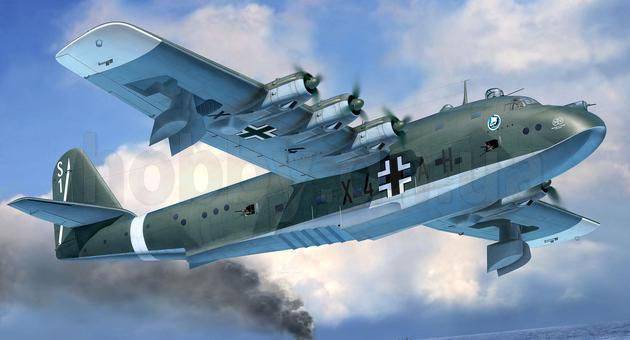
The thirties of the last century were truly "golden" for passenger seaplanes. The absence of the need for airfields and the ability to land an aircraft directly on the water in the event of a malfunction made it possible for flying boats to be out of competition on intercontinental routes compared to ordinary ground vehicles. It is not surprising that leading aircraft-building states rushed to develop this niche, primarily the United States and England.
Loophole left by the Treaty of Versailles (permission to develop civil Aviation) Germany used to the full. By 1925, it had the three largest air companies in the world. Paved airways in South America, the Middle East and China. By the thirties, German airlines began to gradually lose their positions on long lines. The airline Lufthansa began to push the American company Pan American and the British Imperial airways. This trio began the struggle for a monopoly of air travel across the Atlantic.
Back in 1924, at the time of the severe restrictive laws, German designer Claude Dornier was obsessed with the idea of a gigantic plane - a flying boat that would have cargo and passenger flights available between continents. So 2 in November 1930 of the year Do-X started from Friedrichshafen to Lisbon, then to Africa, South and North America, and in the year 1932 returned, having flown over the Atlantic. Soon the first copy of the Do-X crashed during an unsuccessful landing on the Baltic Sea. By order of Italy, Dornier built two more boats, which, however, did not get on the airline. One of the reasons for failure is insufficient engine power. Flight altitude did not exceed 200 m.
The Americans were more successful in their S-42 and in the British with a flying boat like "lmpire-7". They made a two-way deal and opened flights between New York and London. After the failure of the Do-X boat, the German airline did not abandon the hope of conquering the monopoly of air travel across the Atlantic and at the end of 1936, announced a competition to design a seaplane capable of performing non-stop flights on the routes between the Old and New Worlds.
The firms Dornier, Heinkel and the aviation branch of the Hamburg shipyard were invited to participate in the competition. All of them had a lot of experience in the development of flying boats.
In May 1937 of the year, the Hamburg Shipyard was the first to present its project on the R.54. Competitors presented - eight-engine Do-20 and four-engine Non-120 only in September. By this time, the Lufthapsa management had stopped at Na.54, which had been assigned the Na-222 index in the technical committee of the German Ministry of Aviation. The seaplane was calculated on non-stop flights between Berlin and New York with a duration of 20 hours at a speed of 350 km / h with 16 passengers on board.
In January, 1938 began work on building the ordered prototypes. The aviation department of the Hamburg shipyard was headed by Richard Vogt, and he was also the chief designer of the R.54 project. After a lengthy discussion, BMW-132 engines were chosen as the power plant. But soon they stopped at 1000-strong Bramo 323 R-2 Fafnir.
The 54 absorbed all the experience of building a seaplane of this class: in particular, the cockpit floor was lifted 3,05 m above the building horizontal, in the tubular wing spar six sections of fuel tanks were placed according to 3450 l. The side two-section floats after take-off were separated and retracted with the help of electric motors in the wing console.
In September, 1938 of the year on the stocks under Hamburg began to manufacture structural elements. The final assembly took place at Finkenwerder. Meanwhile, the airline's leadership was presented a full-size model of the passenger cabin of a seaplane under construction. It provided for 24 seating and 16 berths. In terms of comfort, the cabin was not inferior to the 5-star hotel. In general, with minor amendments, the mockup commission approved the draft of the cabin of the flying boat.
In connection with the start of the war in Europe, Lufhansa lost interest in the transatlantic boat and stopped financing construction, as it finally became clear that the boat would still be withdrawn for the needs of the Luftwaffe. It should be added here that at the stage of preliminary design there were two versions of P. 54. One is civilian, the other is military, distinguished by installed weapons and a cargo compartment with two large hatches in the side of the fuselage. The completion of the work was already under the flag of the Luftwaffe.
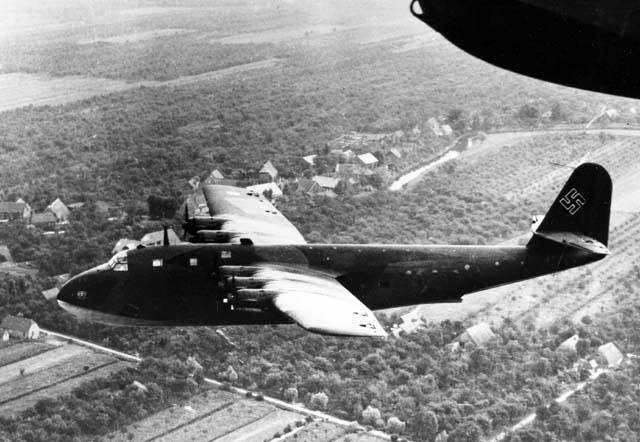
At the beginning of September of the same year, the firstborn BV-222V-1 (the boat received such an abbreviation after separating the aviation department into an independent CB "Blohm und Voss") was tested on the water. Its wing span was 46 m, the length of the fuselage reached 36,5 m, take-off weight - 45,6 t. 7 September 1940, the factory pilot lifted into the air BV-222V-1. The first flight revealed a slight yaw on the water during a takeoff run and a tendency toward exchange rate instability in the air. Factory tests took place before winter, until Elba covered with ice. Then the boat was improved by improving road stability, and large cargo hatches were embedded in the fuselage. As soon as the Elbe cleared of ice, the test flights continued.
They decided to use the boat for military trials in Operation Wasserubeng, ("Teaching on the Weser") to capture Denmark and Norway, together with other transporters and seaplanes from the V-Air fleet. For further flights in the northern latitudes on a flying boat, the bottom was reinforced with additional skin, and in May 1941 the BV-222V-1 flew to Norway.
Until mid-August, the seaplane flew 30000 km between Hamburg and Kirkines over the Barents Sea, transported about 64,5 tons of cargo and took out a wounded 221. During the Norwegian campaign, the aircraft received a respectful nickname from the German soldiers - “Viking”. Upon completion of the assignment, the BV-222V-1 underwent a minor scheduled repair, after which it was decided to use the boat in transport operations in the Mediterranean.
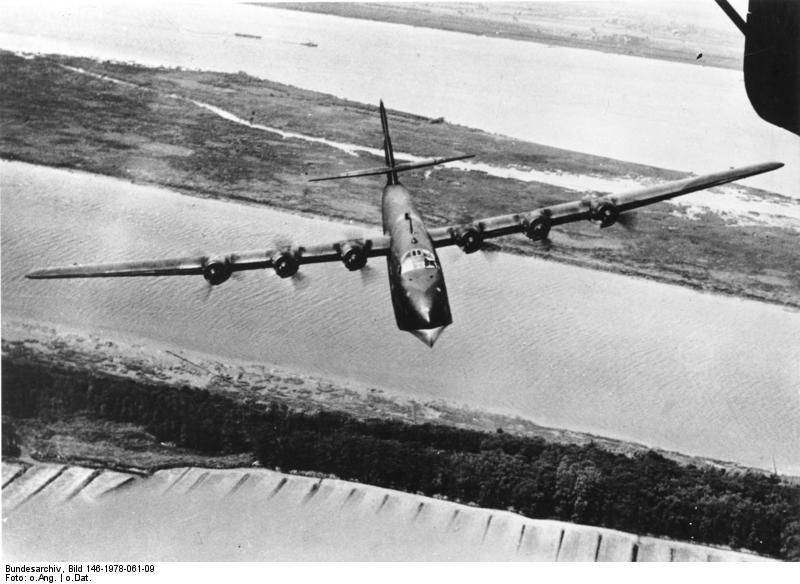
The war in North Africa was unsuccessful for Germany. Under the onslaught of the British, the African corps was experiencing an ever-increasing need for supplies. However, the Mediterranean Sea remained under the control of the Allies, the only means of delivery to Africa was aircraft. The crew was extremely happy with this task: after northern Norway to be in sunny Greece.
In September 1941, the Viking flew to Athens. During the period from October to November, the seaplane performed 17 flights between Athens and Dernoy in Libya, delivered about 30 tons of cargo for the African corps and brought the injured to 515. The flights were made at night and accompanied by two BF-110 Messerschmitts, since the plane did not have defensive armament. At the end of November, the BV-222V-1 departed for planned overhaul to its native Hamburg, during which defensive weapons were to be installed on the aircraft.
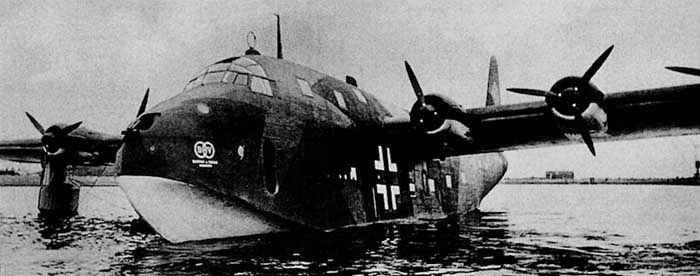
7 August 1941 of the year made the first flight of the second prototype BV-222V-2. It differed from the V-1 installed weapons. In the nose of the fuselage 7,92-mm MG-81 machine gun was placed, on the back there were two MG-131 machine guns of 13 mm caliber, two MG-81 on each board in window slits and two MG-131 in specially designed troughs under the wing between engines. Factory tests took place at the Travemünde test center. After successful first flights for military running in, the boat was recruited for transport operations in the Mediterranean to assist BV-222V-1.
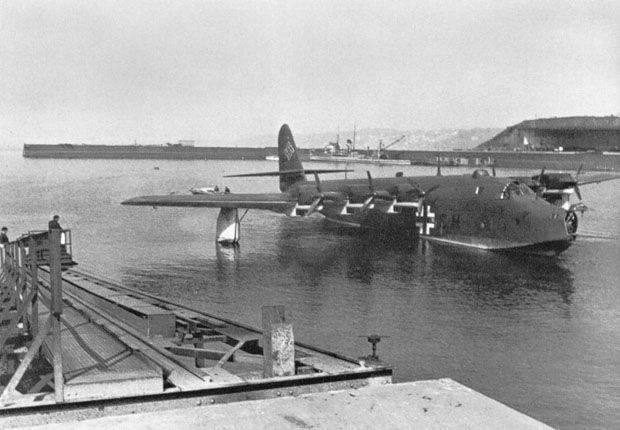
October 8 The X-NUMX of the V-1941, after an 1-hour flight, splashed down in the port of Athens, but not entirely successfully. During the landing, the BV-7V-222 got a hole. When sliding on water, he ran into an underwater fragment of an old iron pile. To find out the size of the holes, the pilot dived under the boat and found a hole about half a meter wide. With the help of two floating port cranes, the boat was raised a meter above the water, and the flight mechanic patched a hole in the bottom. The flying boat again became suitable for transport tasks.
In November 1941, the 3 model BV-222V-3 rose into the sky, which differed from the V-2 in its armament. On the "back" of the fuselage left only the front machine gun installation. After short test trials the boat was sent to the Mediterranean. Until spring, the BV-222V3 flew 21 from Tarento and Brindise to Tripoli, supplying the African corps with food, ammunition and other cargo. In June, three Vikings formed the LTS See 222 maritime transport squadron.
Until the end of 1942, XVUMX Viking BV-222V-4, V-222, V-4 and V-5 entered the LTS See 6 of the year. Seaplanes that were part of this squadron, formed the installation series "A". BV-8V-222 was left at the factory as a prototype for the new version of the Viking. During their stay in the Mediterranean, the Vikings transported 7 tons of cargo, 2043 soldiers and 19750 wounded. The first losses of the BV-2678 are also connected with the transportation operations of the African corps. 222 November 24-th in the area of the island of Pantelleria on the BV-1942V-222, flying from Tarento to Tripoli, attacked two aircraft of the British Air Force and shot down him. After this incident, the single flights of the Vikings were forbidden and ordered to fly only in a group, at night and at low altitude.
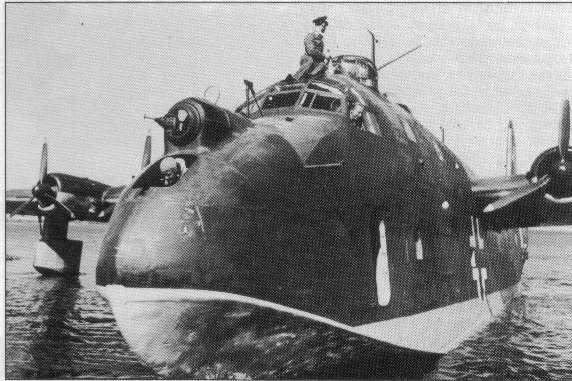
December 10 1942 BV-222V-1, V-4 and V-8 were attacked by three British fighters. As a result, V-8 was immediately shot down, and V-1 and V-4 barely reached the port in Tripoli. This is how John Newby, the commander of the British Air Force squadron, describes this fight: “We suddenly saw three huge planes flying straight at us, ears in headsets laid, blood struck in the head, everyone got a little flustered, but then they saw that this was a familiar flying boat BV-222. We rearranged and went on the attack. My second turret firing shooter opened fire, I saw how the tracer line proportional to one of them. Suddenly, this machine broke out, rolled over and collapsed into the sea. "
After this battle, the commander of the LTS See 222 sent a report with proposals for a new battle formation in flight. Soon the proposals were accepted, and the next loss of the Viking occurred only in the summer of 1943. It was the firstborn of the BV-222V-1. Returning from Africa, the Viking lagged behind the main group and ran into the British air patrol, but was not attacked by them. In the distance, the Athenian port already appeared, out of nowhere, another pair of English fighters flew out and attacked the BV-222V-1. From the first approach, the lead fighter arson is one of the Viking's right-wing engines. In clouds of smoke, the boat went down. Having decided that it was all over with the plane, the British pilots headed for their airfield on the island of Malta. All the wounded "Viking" still reached the raid of the Athenian port and splashed down. In a matter of minutes the boat sank, but the crew managed to escape.
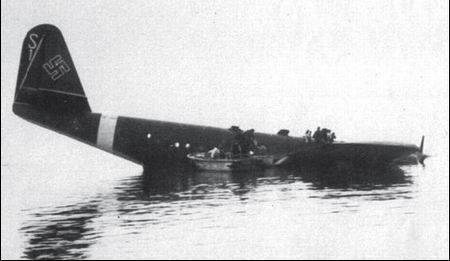
In the summer of 1943, BV-222V-2 and V-5 were sent to Travemünde for revision. Enhanced armament (they replaced the MG-81 bow machine gun with the 20-mm MG-151 / 20 cannon), installed the engine boost system with the MW-50 water-alcohol mixture, after which the take-off engine power reached the 1200 hp. On the V-2n V-5 installed equipment to search for submarines and surface ships of the enemy. These two Vikings formed the ALS See 222 and operated in the Atlantic to guide submarines and aircraft on enemy convoys.
In May, the 1943 of the year the German African Corps capitulated, and the surviving BV-222 relocated to the French Atlantic coast and, after being upgraded, were introduced into the ALS See 222. During the British bombers' raid on the base, in July 1943, two Vikings died in the raid: V-3 and V-5.
The only air victory of BV-222 is connected with staying in France. In one of the flights to patrol the Atlantic, in which participated BV-222V-2 and V-4, the Vikings saw a lonely flying plane, along the contours similar to the English bomber Avro "Lancaster". Approaching and making sure that this is the enemy, the Vikings summoned their fighters. Noticing that the Englishman was leaving the zone of the interceptors, they turned around, and without waiting for reinforcements, they boldly went on the attack. After several visits to the target, they shot down a lonely bomber and recorded the victory at the expense of the crew of the BV-222V-4. Until the end of the war, the BV-222V4 flew over the Atlantic to target allied convoys of submarines and aircraft. During the announcement of surrender, the flying boat was in the roads of the port of Kiel-Holtenau, where it was flooded by its crew.
One of the most difficult missions in which the Viking participated was the Arctic operation Schatzgraber (Treasury) in June 1944. In winter, 1943-1944 over the Arctic Circle, on the island of Karl-Alexander, part of the Franz Josef Land Archipelago, was founded a military weather station. The main task of this station is to provide mete information for submarines that travel in northern latitudes. The station’s crew consisted of three people: a meteorologist, his assistant and a radio operator. During one of the communication sessions with the “Bolshoi Zemli”, the wintering chief meteorologist V. Dries reported that polar bears looted half of the food stocks. A little later, the radio operator in the Norwegian Banak accepted the message: "Urgently send help, the products are running out, my assistant poisoned with rotten bear meat, the task is in jeopardy. Dries."
The vast area between Norway and Franz Josef Land is covered by a frozen ocean. The only possible vehicle at this time of year was the aircraft. To participate in the operation attracted FW-200C-3 "Condor", based in Norway. For additional aviation support used BV-222V-2, located on the coast of France. In early June 1944, the Viking flew to Billy Fjord in northern Norway. The crew commander was a flyugkapitan mehring. 4 June the boat took off from Biskarasse on the route Travemünde-Tronso-Billy Fjord. Until the moment of arrival in Norway, the crew did not know the purpose of their flight. At the new location, a new camouflage was put on the boat. Upon readiness, the crew was briefed in a secret form for the purpose of its closest mission: to assist the Condor if he had any problems.
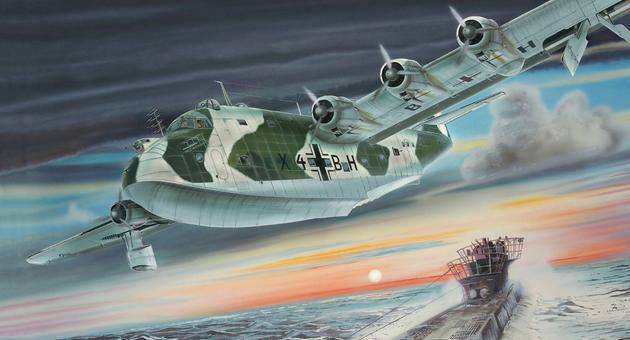
June 7 FW-200 took off from the airfield in Banak and headed for the "unknown". The task of the crew "Condor" included the delivery of all necessary to the polar base. The first 700 km passed through a radio compass tuned to a radio beacon in Banak. Then the main burden fell on the shoulders of the navigator, who brought the plane exactly to a given point. Upon reaching the place of the meteorological station, the pilots saw below the signal bonfires, denoting the landing strip. Going against the wind, "Condor" sat down, but not successfully. On the run, the wheel hit a sharp stone and snapped; the second wheel of the right landing gear exploded during emergency braking. For several hours the plane was unloaded. The radio operator contacted Banak and reported on the incident and requested: spare wheels, lifting bags and compressed air cylinders to fill them.
8 June BV-222V-2 flew over the Arctic Circle to the aid of the Condor. About one o'clock in the morning the boat sat on the spot indicated by bonfires, delivering everything necessary for repairing the aircraft. A few hours later, the Viking flew back to Norway. 11 June about two o'clock in the morning through 80 hours after the start of the FW-200 landed in Banak. For participation in this operation, both crews were awarded.
Until the end of the war, the BV-222V-2 was used to patrol the North Atlantic from bases in Norwegian fjord. This Viking met Germany’s capitulation at a base in Trondheim, where it was captured by English troops.
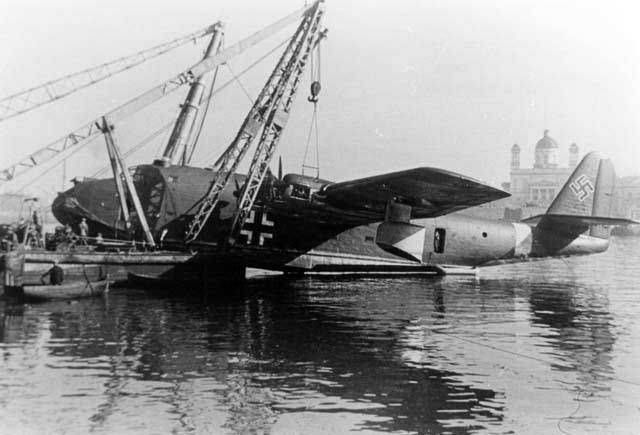
In 1939, during the construction of the BV-222V-1, R. Vogt sent to the Technical Committee of the Ministry of Aviation a seaplane modernization plan: BV-222B with Jumo-208 and BV-222C engines with Jumo-207С, intended for further maritime reconnaissance. The technical committee approved the project using the Jumo-207C diesel engine on the Viking. The prototype of the same version was the BV-222 V-7, which made its first flight in April 1943. The aircraft was armed: in the nose of the 13-mm MG-131 machine gun, on the back and in the side slits of the fuselage - the MG-7,92-mm machine guns MG-81, on the wing planes one MG-131. To improve the characteristics of the take-off used rocket boosters.
In August, 1943, the BV-222V-7, became part of the ALS See 222. The task of patrolling the Atlantic Ocean, this flying boat performed until the end of hostilities in the region. In April, 1945, the boat flew to Travemünde for scheduled maintenance. In the first days of May, guided by the order of the command, the BV-222V-7 was flooded by its own crew.
During 1943, four more BV-222Cs (C-222-1, C-09, C-010, C-011) were added to ALS See 012. The BV-222C-013 aircraft was left at the factory as a prototype of the following modification, equipped with Jumo-207D engines with an 1500 hp take-off power. The company "Junkers" could not bring this engine "to the mind", and therefore on the BV-222C-013 put regular diesel Jumo-207C. On the stocks of the plant in Hamburg laid the following four copies of version "C".
Soon, the aviation ministry suspended the construction of new Vikings, arguing its decision by the lack of Jumo-207C and the unavailability of Jumo-207D. Interestingly, in September 1941, the Ministry of Aviation approved the BV-222 construction plan at the Blohm und Voss factories in Bremen and Weserfluge, according to which 1945 Viking-type flying boats should be produced by the end of 86. During the discussion, R. Vogt proposed to allocate BMW-222 motors for the four BV-801 being built, but the Technical Committee rejected this proposal. Then the designer achieved the selection of 24 motors BMW-Bramo 323 R-2 Fafпir, which were installed earlier on version "A". The new modification has received the index "E". The aircraft of the latest version was not built until the end of the war. In connection with the situation on the fronts, the financing of the program "Jagernot" ("Sea Hunter") was closed.
The flying boat BV-222V-9 (С-1-09) was officially the first production boat of the version "C". At the end of the factory tests, she was sent to Travemunde. Having arrived at the disposal of the test center, the BV-222V-9 was preparing to carry out a secret mission over Greenland. For maximum efficiency, two short-wave and one medium-wave FuG-10 radars were installed on this Viking. The crew only knew about the upcoming mission that soon they would fly to Norway.
After the additional equipment, the Viking was painted in polar camouflage in blue and white. With full secrecy, BV-222V-9 in October 1943 flew to Norway and headed for Trondheim. The flight took place at a very low altitude, so as not to be detected by English fighters, and was very difficult: low air temperature, poor visibility in the polar night. On the approach to the shores of Norway, the Vikings launched anti-aircraft fire from German coastal batteries: air observation stations in the mist of the polar night took it for a completely different plane. Fortunately, everything ended well, the flying boat landed in Trondheim. The next day, the Viking flew to Tronso. About this flight there was radioed with a conditional phrase: "Wait for Aunt Emma."
In 1943, the secret meteoronavigation base Coburg was established in the north-west coast of Greenland as part of Operation Contrabas. Its main task was the meteorological support of the German air raids on England. After arriving in Tronso, the crew was informed of the main purpose of their flight: to deliver food, medicine and other necessary goods to a secret base. At this time, the weather deteriorated sharply, and the flight to Greenland was constantly endured. 16 November in the evening appeared in the sky gaps, and meteorologists gave a favorable forecast for the next day.
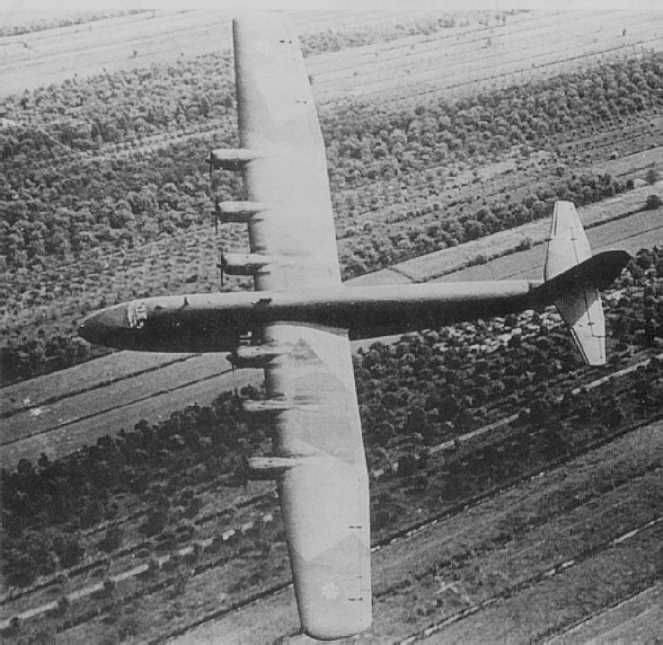
17 November early in the pitch darkness the BV-222V-9 took off. After 15 minutes after takeoff, the Viking commander turned his attention to the heat of one of the engines and dropped speed, but then turned it off. In the design of the aircraft for ease of operation, in the wing box there was a passage to the motors. They also took advantage of the flight mechanic. He made his way to the faulty engine and discovered the reason for the temperature increase: the cooling system hose broke, he reported to the crew commander, who made a decision: eliminate the fault, start the engine and continue the flight in normal mode. Having found a suitable hose, the malfunction eliminated and started the engine.
Soon the weather deteriorated sharply, visibility dropped to zero. The jogger managed to make a short contact with the base in Coburg and ask them to periodically give a radio signal. The Viking went down to the minimum allowable height and went to the radio beacon of the secret station by bearing, but did not see anyone and anything on the ground.
Having made several useless circles over the point, the commander gave the order to lie down on the opposite course, but he fell into a zone of heavy snowfall and icing. After the 12-hour flight, the flying boat returned to Tronso.
After an unsuccessful mission for the Arctic Circle, the boat was introduced into the ALS See 222. Until the end of 1944, this Viking was performing regular tasks over the North Atlantic. At the beginning of 1945, the boat was based in Travemünde, and repairs were carried out on it. In one of the raids on the base, British planes shot down a defenseless flying boat that was stationed at the port.
BV-222V-11 entered the ALS at the end of 1943 and, until the end of hostilities, flew over the Atlantic. At the end of the war, the plane was captured by American troops and shipped to the United States for study and testing, after which it was turned into scrap metal.
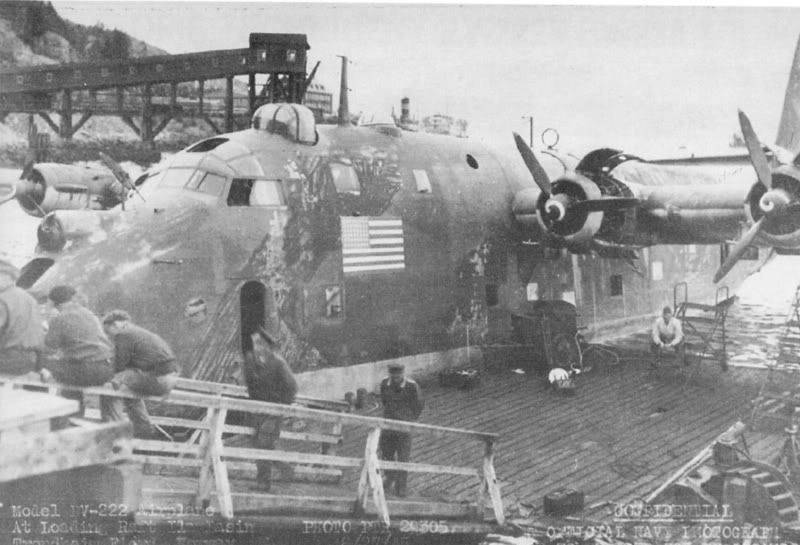
BV-222V-12 (C-012) was captured by the British. He was transferred to the base of the Navy and entered into the 201-th division of the Royal Air Force. During his stay in England, he was given the number AM-138 with the red “P” printed on the fuselage. In the middle of 1947, the boat was written off as having served its time.
The last of the built "Vikings" - BV-222V-13. He did not take part in the fighting, as he was left at the factory as a prototype of the new version of BV-222D. After the war ended, BV-222V-13, like V-11, fell into the hands of the Americans. A little later, he was transported to the United States for research, after which they passed into scrap metal.
The career of the flying boat BV-222 was short, but bright enough. The aircraft flew both in Africa and beyond the Arctic Circle. Not a single flying boat of that period had such flight characteristics as the Viking. A further sequel to the BV-222 was the BV-238, but the war was already ending.
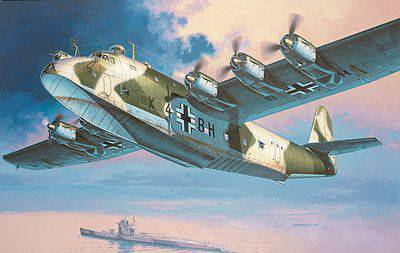

Sources:
Green William. Wings Luftwaffe. Blom und Foz // Aviation and Cosmonautics. 1997. No.11-12. C.55-58.
Kotelnikov V. Seaplanes of the Second World War // Air Collection. 2003. No.2. C. 21-22, 93.
Kolov S. Vikings over the sea // Planes of the world. 2003. No.1. C. 41-45.
Kolov S. German flying boats BV-222 // Wings of the Motherland. 1999. No.3. C. 24-27.
Obukhov V., Kulbaka S., Sidorenko S. Planes of the Second World War. Minsk: Potpourri, 2003. C.166-167.
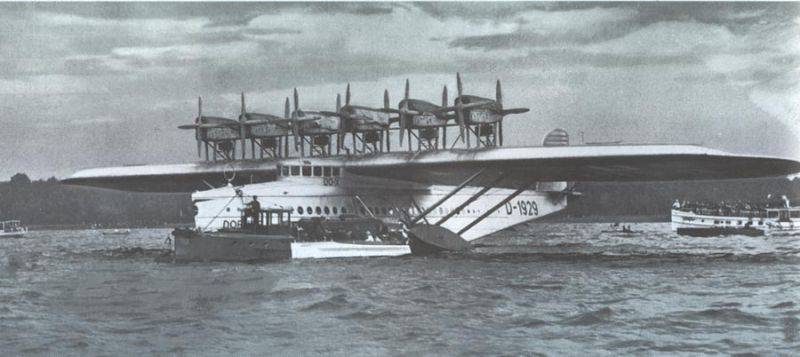
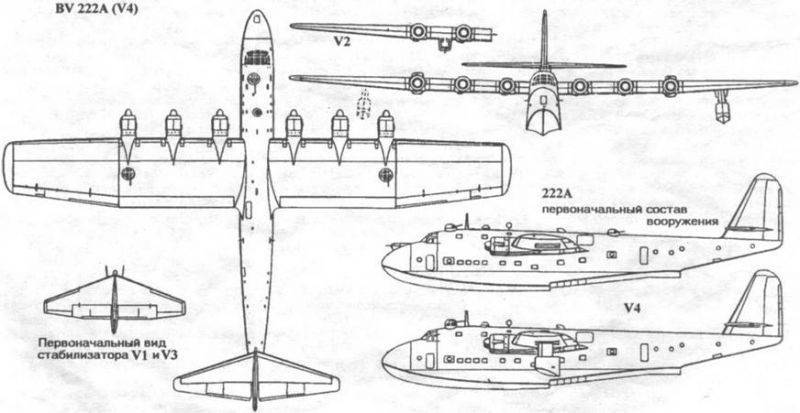
Information